Sulcata tortoises will eventually need lots of space, daily attention, and dedicated keepers who align with their species-specific care and lifestyle.
Sulcata tortoises (Centrochelys sulcata) are giant grassland species that are some of the most commonly available captive-bred tortoises in the pet trade. And while it is certainly wonderful that they are being so successfully bred in captivity, they are not always successfully kept. Their widespread availability and affordable prices has perhaps led impulse buyers who are not prepared for their care to acquire them. With the amount of information now available on sulcata tortoises, it is possible to keep sulcata tortoises thriving in captivity. When kept properly, sulcata tortoises can live a long and leisurely life alongside their owners. It is important to understand the requirements associated with keeping tortoises, especially those that are giant, like sulcatas! The sulcata tortoise is the largest mainland species of tortoise, and the third largest tortoise species on the planet. They come from a dry, arid, desert habitat in northern Africa.
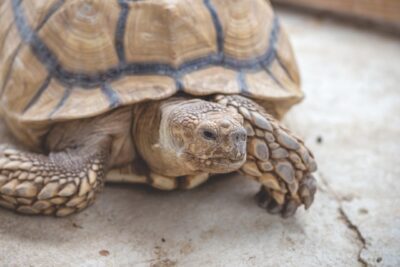
The sulcata tortoise is also known as the African spurred tortoise, or African spur-thighed tortoise.
Description
Sulcata tortoises, also known as the African spurred tortoise or African spur-thighed tortoise, are large, terrestrial chelonians that can reach hundreds of pounds and live for more than 100 years. It would be no surprise for a sulcata tortoise to live much longer than its original owners. If you are willing to pass a tortoise through generations of your family, this is the tortoise for you. Sulcatas are the only extant species within their genus, Centrochelys, with all other subspecies being extinct. They used to be classified within the Geochelone genus, according to some sources. Like many reptiles, classification is often debated. Sulcatas are currently the largest species of mainland tortoise, and the third largest tortoise species overall. The only species larger than sulcata tortoises are the island giant Galapagos tortoises and giant Aldabra tortoises. These mainland dwellers are much different compared to their giant island counterparts, which includes their species-specific care.
Wild Habitats
Sulcata tortoises are native to Northern Africa, where they live in scattered populations within the Saleh region south of the Sahara desert. This region spans countries east to west such as Chad, Eritrea, Ethiopia, Mali, Mauritania, Niger, Nigeria, Senegal, and Sudan to name a few. They may be extinct in some historic regions like Togo, and population distribution of the species is poorly understood in general. The Sahara is the third largest desert in the world, beaten only by the Antarctic deserts. The habitats of the Sahara are mostly dry and arid, with seasonal rain that varies depending on the region. Temperatures can range from 77 to 120 degrees Fahrenheit (25.0 to 48.8 degrees Celsius), usually never becoming cold. This is an important consideration for sulcata care in captivity.
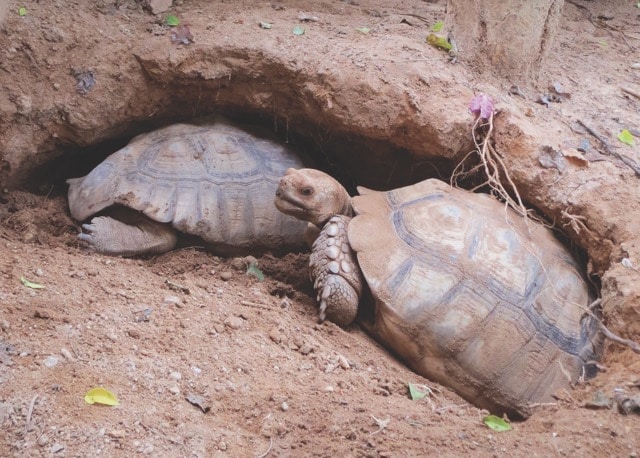
African spurred tortoise at burrow entrance. Photo by Seasoning 17/Shutterstock
The Saharan habitat is subdivided by many ecological regions ranging from deserts to mountains. Over the huge spans of the Sahara desert, coastal areas are bordered by different oceans, while most other regions are completely landlocked. This heavily influences the micro-climates and ecosystems of each region. The southern portion of the Saharan desert where many sulcatas live is a special transitional zone that leads into other regions of Africa that are not desert.
Unlike the giant island tortoises, sulcatas face more predators in their wild habitats, but are mostly affected by the brutal climate, interspecific competition, hunting for bushmeat, and natural disasters like bush fires. The Sahara can be home to fierce predators like hyenas, lions, pythons and crocodiles in some places. Compared to some other ecosystems on the planet, like rainforests, Saharan biodiversity is less and many creatures only pass through because of its harsh environment. Still, it is a special habitat that is home to different life forms. Animals like sulcatas who manage to make the Sahara their home, rely on unique features and behaviors that have allowed them to survive here.
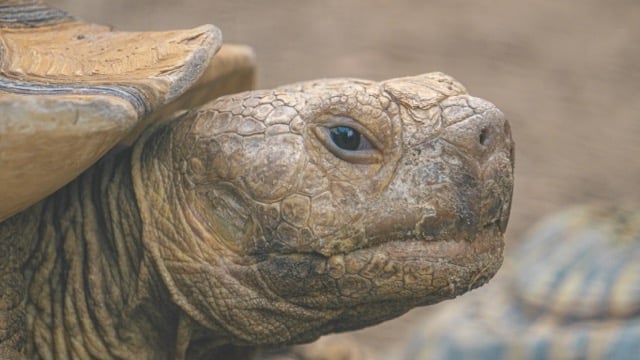
Close-up portrait of an African Spurred Tortoise (Centrochelys sulcata). Also called the sulcata tortoise, it lives in the Sahara desert in Africa and is the largest mainland species of tortoise. Photo by AstroVictor/Shutterstock
The sulcata tortoise faces a harsh life of survival because of the climate of its Saharan home. They inhabit the desert, grassland, scrub, and savannah habitats of the Sahara desert where they live a mostly solitary, crepuscular life. These factors contribute to the lifestyle, behaviors, and overall requirements of the sulcata tortoise, which must be considered in captivity. When keepers consider where this tortoise comes from, keeping them may be more manageable and successful. Every tortoise species is special, and each sulcata deserves a home that is prepared to keep them throughout the entirety of their lives. This can be challenging and overwhelming for those who are unprepared, so research before ownership is imperative. With improper care, sulcata tortoises face neglect, sickness, or abandonment that can leave them homeless and/or in need of rescue. Responsible stewardship is vital for the health of captive reptiles and for the positive representation of the animal industry.
Physical Characteristics
The sulcata tortoise is a huge species that, like all other turtles, begins quite small. They hatch from the egg at just a few inches, resembling a pale yellow ping pong ball. Their shells are tan in color with skin that resembles the color of sand. These cute tortoises grow to be hundreds of pounds as adults and typically grow exponentially before plateauing. This can be variable depending on individuals and few color morphs exist, like albinism. While very cute and small as hatchlings, they can grow rapidly into large reptiles that have a personality that matches. Sulcatas have been very affordable because they are commonly available in captivity. Their captive-bred success is wonderful for their conservation since sulcatas are classified as endangered in the wild.
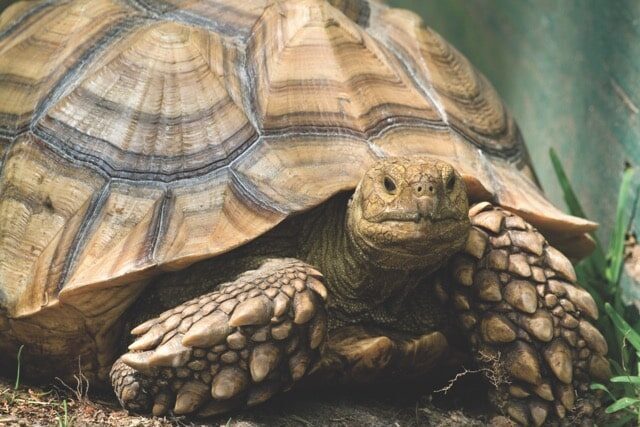
The sulcata tortoise is a huge species that, like all other turtles, begins quite small. They hatch from the egg at just a few inches, resembling a pale yellow ping pong ball. Photo by Seasoning 17/Shutterstock
Sexual dimorphism exists in the species, where males have a large gular plate that extends from their plastron, a longer tail, differing cloacal placement, and a concave plastron. Female sulcata tortoises have a reduced gular scute, shorter tails, a lower placed cloaca, and a flat plastron. The gular scute is a structure that protrudes out from underneath the chest areas and is larger in males typically used for combat, mating, and other behaviors. Sulcata tortoises have spurred shaped scales on their legs which is how they got their other common name, the African spur-thighed tortoise. Sulcatas have tough skin to prevent water loss and strong shells that protect them from predators.
Behaviors
Sulcata tortoises live a solitary life in the wild, where they are described as being active during dawn and dusk as a crepuscular species. In order to survive their harsh wild habitats, sulcatas rely on estivation where they create complex, deep burrows in the ground to escape the heat. These burrows can be huge with tunnels connecting them and some other animals may use their burrows as well. These burrows help with thermoregulation to maintain proper body temperatures and gives them a place of refuge. These burrows also help with humidity levels, according to some sources. In the wild, sulcata tortoises rarely get water so they must rely on a variable diet that provides hydration, like cacti, weeds, and grasses. These adaptations help them survive in the dry and arid Saharan desert. In captivity, life should be more comfortable for sulcatas but should still replicate naturalistic conditions.
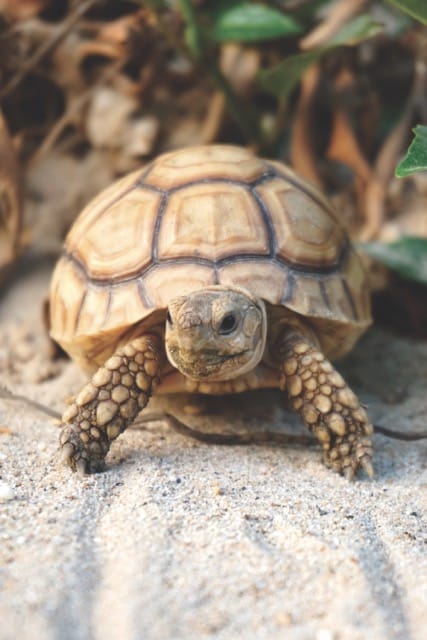
Close up African spurred tortoise resting in the garden. Photo by Vertical Seasoning/Shutterstock
Sulcatas do well alone, and should only be kept together if behaviors can be monitored to make sure the dynamics are safe. Males will fight each other, sometimes to the death, which can create horrible injuries. Females can be kept with other females before sexual maturity, and males can be kept with females only during breeding. Injuries can occur from combat and/or mating and in some scenarios they can be severe. Sulcata behavior can be described as more aggressive compared to other tortoise species, but they are not typically dangerous to humans.
It is understandable for them to be more aggressive since they come from a harsh mainland environment with predators like rock pythons and leopards, compared to giant island tortoises that live more leisurely in the wild. Sulcata tortoises live a slow and steady life, where they forage as a grassland species and prove to be hardy survivalists. Turtles and tortoises have remarkable senses and abilities like magnetoreception, which helps them navigate their worlds. More research is needed on the behavioral and sensory biology of these tortoises.
Diet
Abnormal, rapid growth should not be facilitated by improper diet and slow and steady is always the preferred method of growing for turtles and tortoises in captivity. Abnormal diets can cause shell pyramiding that can be severe and unattractive. Sulcata tortoises are primarily herbivorous, feeding on a grassland diet in their wild habitats which provides them vital nutrients like calcium and Vitamin D3. This diet can include grasses, weeds, and cactus, and very low levels of protein. They may feed opportunistically on carrion or dead plant matter to help them survive in the wild.
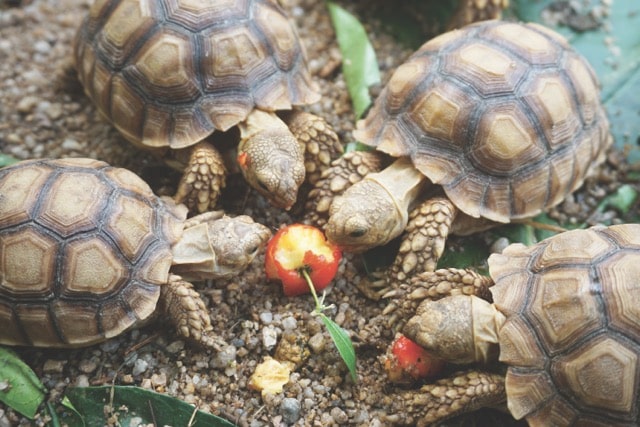
Hatchlings sharing a meal of fresh fruit. Photo by Seasoning 17/Shutterstock
In captivity, a variable diet is the most important element to keeping tortoises healthy, both inside and out. Improper diet can lead to a plethora of health issues like shell pyramiding, metabolic bone disease, and other conditions. Leafy greens like spring mix, dandelion greens, red and green leaf lettuces are good staples, along with hays and low sugar fruits like papaya and dragonfruit. Commercial options can also be used supplementally in captivity along with a variety diet. Giant tortoises like sulcatas require lots of food, and this can become expensive as they grow into their adult sizes. There are many suitable diet options for sulcata tortoises, and extensive research is encouraged.
Breeding
Sulcatas can reach sexual maturity around 15 years old and breeding and laying eggs can be seasonal. This will vary depending on conditions in the wild or captivity. Sulcatas will exhibit natural behaviors of breeding and nesting to lay eggs, where females may lay several test nests before depositing eggs in the ground. Females will lay between 10-25 eggs generally and they will hatch around 100 days of proper incubation. This can be variable depending on the individual, though. Males tend to be aggressive where they fight other males for breeding rights and during mating they may ram into the females, potentially causing injuries with their protruding gular scutes.
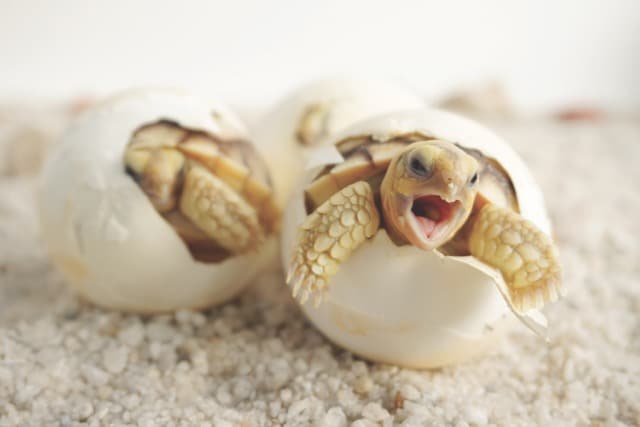
Baby tortoises hatching. Photo by Shutterstock
Captive breeding is very successful in the United States, with sulcatas being widely available at nearly every reptile show. This abundance has caused the market to become saturated with sulcata tortoises, with prices being “cheap” compared to the other giant tortoise species. This makes impulse buying a sulcata tortoise more common, since they are much more affordable than other species. It is important to support reputable captive breeders when purchasing a sulcata tortoise.
Hatchling Care
Hatchling tortoises should be kept indoors, unless completely predator-proof and protected from temperature extremes. Keeping them indoors for the first few years of life is typically a best practice for keeping hatchling tortoises. This allows the keeper to artificially control the best conditions for the hatchling tortoise to grow in, but each species has specific parameters for their care including heating, lighting, and substrate. Like all reptiles, a hot side and cool side is necessary for captive habitats to promote natural behaviors of thermoregulation. This allows the captive reptiles to behave naturally and regulate their body temperatures. Sulcata tortoises will do well in conditions that replicate their wild habitats, but should be more comfortable compared to the harsh Saharan wilderness. Temperatures ranging from 77 to 100 degrees Fahrenheit (25 to 37.8 degrees Celsius) are suitable, but each situation will be unique depending on where the captive specimen is located. Temperatures should never be below 75 degrees Fahrenheit (23.9 degrees Celsius) indoors or outdoors. A sulcata in Florida will require less humidity supplementation compared to a sulcata living in Colorado, for example.
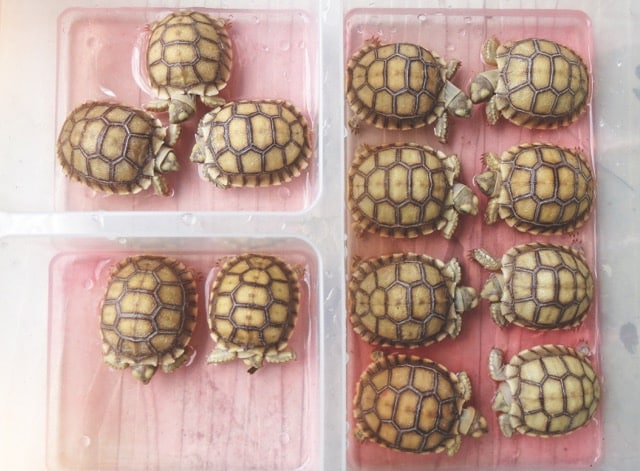
Baby African Spurred Tortoise sunbathe and drink Water, Closeup of a small tortoise ,Geochelone sulcata, Baby African spurred tortoise soak in water. Photo by Eric Isselee/Shutterstock
The captive conditions will be variable depending on the location of the keeper/captive tortoise. Captive conditions must be modified to match each scenario and research is highly encouraged. Trial and error may be required to get the perfect set up for each captive habitat and that is often a part of keeping exotic species. Although each reptile has species-specific care, each individual may also have special requirements.
Hatchling tortoises can be kept in custom commercial habitats or simple plastic tubs. These should be solid colors, instead of clear, to prevent insecurity of the tortoises. Many reptiles may feel insecure with clear habitats because they can see through them. For hatchling sulcatas, heavy duty containers or the bottom portions of rabbit cages can be suitable as long as there is enough space for a “cool side” and a “hot side” and tall enough they cannot climb out. Avoid glass terrariums for tortoise hatchlings. The habitat should provide hiding spaces like commercial caves and huts. These hides should have perimeters that are straight opposed to rounded, to prevent a sulcata hatchling from climbing and flipping over, which can be fatal.
A small dish for food can be provided and soaking the tortoises instead of leaving a water dish inside the habitat is a best practice for hatchling tortoises. With water dishes in the captive habitat there is a risk of tortoises flipping over and drowning. Water soaks also help the hatchling tortoises go to the bathroom easier.
Substrate must be provided for sulcata tortoises since they naturally burrow. There are a variety of commercial options available like reptile safe sand and soil. There are also special substrates made for excavating species that can be considered, but research is encouraged to find the best option for each keeper.
Heating and lighting must be supplemented for indoor captive setups because ultraviolet (UV) is incredibly important for tortoises. Tortoises must get the appropriate spectrums of UV so that they can grow and function properly. When kept indoors, sunlight must be supplemented artificially, which is fine when done properly. I have had success with hatchling tortoises under the 60W Solar Glow All in One Reptile Bulb for both lighting and heat. This all-in-one bulb provides UVA, UVB, and UVC required for tortoises, while also providing a heated hotspot. This bulb must be replaced approximately every 3 months because some of the UV may stop working, even if the visible light remains on. This large bulb requires a large domed fixture and stand that should be placed on one side of the habitat, to represent the “hot side.” Since this bulb is very powerful, it is not suitable for small habitats.
Other lighting options are commercially available which may also be suitable, as long as they provide all three spectrums of UV: UVA, UVB, and UVC. Cycles of day and night should be provided to match naturalistic conditions, and these can be monitored manually by switching the bulb on and off (8 hours on, 8 hours off) or using a commercial timer. Heating and lighting should always be monitored with thermostats to make sure there is no risk of overheating or fire hazards. This is why glass is not typically recommended for tortoises since it can trap heat and cause temperature spikes that could kill tortoises.
Sulcata tortoises need some levels of humidity, which can be supplemented by misting the habitat, but not the tortoise directly. This is especially important if AC is inside the room where it is kept because it can be comparable to stepping out of the shower with no towel! Cold and wet is a very bad combination for tortoises because it can make them very sick. Ceramic heat emitters can provide supplemental heat during cold times. Make sure they are attached to a proper fixture and thermostat to monitor conditions. Hatchling tortoises are much more fragile than adults, because their shells are thinner and they are very small at this stage. They are more susceptible to dying from temperature extremes and are generally weaker at this point.
If a hatchling tortoise is kept outside, it is imperative that they are protected from predators from all sides, like fire ants from below, birds from above, racoons, cats, and anything else imaginable. It is not recommended keeping hatchling tortoises outside and this should only be done if adequate space, shade, water drainage, security and protection is absolutely provided at the highest standards possible.
Adult care
Adult sulcata tortoises will eventually demand large, outdoor spaces. This species is known to NOT be respectful of the parameters of a captive habitat, and are talented escape artists that can be destructive. They are strong, determined reptiles that can break through the toughest barriers and dig up entire backyards. Their tough demeanors and bullish attitudes can be an unexpected challenge for keepers who do not realize their fierce and resilient personalities make them quite active and persistent in captivity. They are from the brutal desert, afterall!
Sulcatas deserve large spaces to roam that are strong and secure. Adult sulcatas can have water dishes in their habitats as adults since they will be too large to soak in a separate container. Filtered shade is important outdoors to provide cooler spots for thermoregulation and enrichment for captive scenarios. The more, the better and keepers are encouraged to experiment with what works best for them and their animals. Avoid areas where tortoises can climb and potentially flip over or become trapped. Do not cohabitate different species of tortoises at any age as this risks pathogen cross contamination between species and/or possible behavioral issues.
Conservation and Conclusion
While it is amazing that captive breeding efforts have been very successful for sulcata tortoises, they are often sold for prices far below their worth in captivity. This unfortunately attracts many buyers who may not be prepared for the reality of this huge character of a tortoise. Sulcata tortoises are not very well understood in the wild, and populations seem to be fragmented, declining, or perhaps completely extinct in some areas. Many sources mention that sulcata tortoises are declining in the wild due to competition for space and food, with local livestock. The IUCN lists them as endangered and it is great that captive breeding has relieved the pressures of wild collection. This is wonderful for their conservation but careful consideration is needed before acquiring this widely available species. It is also important to check with local/state laws to make sure that sulcata tortoises are allowed to be kept in your region.
Sulcata tortoises will eventually need lots of space, daily attention, and dedicated keepers who align with their species-specific care and lifestyle. They are not a beginner species, although they are seemingly inconspicuous as tiny, cute hatchlings. These adorable, small tortoises reach hundreds of pounds and can become a challenge to those who are unprepared. This has led to many sulcatas being abandoned or in need of rescue, which is unfair to them and reflects poorly on the reptile industry. Sulcata tortoises deserve so much more than the cheap price tag and impulse purchases they are often subjected to.
With proper research, preparation and understanding, a sulcata tortoise will be an incredible family member that provides the rewarding and unique experience of keeping a giant tortoise. They can literally live beside their keepers for the entirety of their lives. Since they are much more affordable than the other species of giant tortoises, sulcatas can be a wonderful option for someone looking to take a giant step in responsibility alongside these huge characters. Sulcatas deserve consideration and love (and a large outdoor space) that matches their huge personalities and sizes. With responsibility and preparedness, the world for captive sulcatas can change for the better.
Sources
- https://www.2feet4paws.ae/african-spurred-tortoise-geochelone-sulcata/
- https://www.iucnredlist.org/species/163423/1006958
- https://www.researchgate.net/profile/Lucasuiselli/publication/306347172_A_survey_of_the_potential_distribution_of_the_threatened_tortoise_Centrochelys_sulcata_populations_in_Burkina_Faso_West_Africa/links/5bca0126a6fdcc03c795feb3/A-survey-of-the-potential-distribution-of-the-threatened-tortoise-Centrochelys-sulcata-populations-in-Burkina-Faso-West-Africa.pdf


